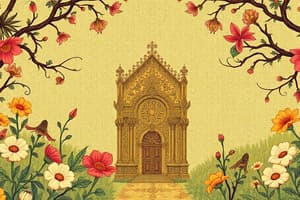Podcast
Questions and Answers
How does the element of line in art direct the viewer's focus and what role does it play in controlling the narrative or emotional experience of a piece?
How does the element of line in art direct the viewer's focus and what role does it play in controlling the narrative or emotional experience of a piece?
Line guides the viewer's eye and influences the narrative or emotional experience. It either directs a viewer to a focal point or evokes a sense of movement, depth, or emotion.
Explain how the manipulation of space within a sculpture impacts the viewer's perception of its size and how they interact with it.
Explain how the manipulation of space within a sculpture impacts the viewer's perception of its size and how they interact with it.
When the space within a sculpture is manipulated, this can change the percieved size. Space guides interaction with the art, influencing movement and perspective.
How can contrast be strategically employed within a composition to amplify specific elements of art so that they command the viewer's attention, contributing to a deeper emotional or narrative impact?
How can contrast be strategically employed within a composition to amplify specific elements of art so that they command the viewer's attention, contributing to a deeper emotional or narrative impact?
Contrast can amplify specific elements of art so that they command greater focus to a viewer. This contributes to a deeper emotional or narrative impact within the piece.
In what ways can the strategic use of rhythm, incorporating varied elements and tempos, lead to a more dynamic and immersive viewing experience, inviting viewers to explore the artwork more thoroughly?
In what ways can the strategic use of rhythm, incorporating varied elements and tempos, lead to a more dynamic and immersive viewing experience, inviting viewers to explore the artwork more thoroughly?
How does an artist's management of unity and variety influence the overall impact of their work, and what strategies do they use to strike a balance that conveys depth and coherence so that it resonates with viewers on an intellectual and emotional level?
How does an artist's management of unity and variety influence the overall impact of their work, and what strategies do they use to strike a balance that conveys depth and coherence so that it resonates with viewers on an intellectual and emotional level?
Flashcards
Line in Art
Line in Art
A line leads the viewer's eyes throughout an artwork and has length and width.
Shapes in Art
Shapes in Art
Shapes are 2D areas showing an object's form and its layout in space. They determine dimension.
Spaces in Art
Spaces in Art
The area between, around, above, below, or within objects. Spaces can be flat, 2D (painting), or 3D (sculpture)
Texture in Art
Texture in Art
Signup and view all the flashcards
Balance in Art
Balance in Art
Signup and view all the flashcards
Study Notes
Elements of Art
- Lines lead the viewer's eyes throughout an artwork.
- It can guide eyes into, around, and out of visual images within the artistic frame.
- A line has width and length, but its length typically occupies more space than its width.
- Shapes are two-dimensional areas that show the form of an object and its layout in space.
- Dimension is the amount of shape an object occupies in one direction.
- Shapes can be geometric or free-form.
- Space refers to outer and inner space, the emptiness and area between, around, above, below, or within objects.
- Space can be flat or two-dimensional, like in painting, or three-dimensional, like in monumental sculpture.
- Texture refers to how things feel when touched.
- Tactile texture is experienced when touching something to feel its texture.
- Visual texture is felt when looking at a photograph or image with texture, reminding you of how those objects feel.
- Color is an element resulting from light waves reflected from objects.
- Hue is a specific color in the color spectrum or bands of color in a color wheel.
- Value is indicated through the lightness or darkness of a color.
- The amount of light in a color determines the color value; pressing a pencil hard creates a dark value.
- Tint is the light value of a hue.
- Shade is the dark value of a hue.
- Intensity is the brightness or dullness of a hue.
Principles of Art
- Balance is the visual weight of elements in a composition, providing a sense of stability.
- Imbalance in a painting can cause discomfort.
- Emphasis is when an artist creates a visually dominant area that attracts the viewer's attention, often achieved by contrast.
- Contrast is the difference between elements of art in a composition, making each element stronger and commanding attention.
- Movement is the result of using elements of art to guide the viewer's eye around and within the image.
- Rhythm is created by movement implied through the repetition of art elements in a non-uniform but organized way.
- Rhythm relates to rhythm in music and relies on variety, unlike pattern, which demands consistency.
- Pattern is the uniform repetition of elements of art or their combinations.
- Anything can be turned into a pattern through repetition, such as classic patterns like spirals, grids, and weaves.
- Unity/Variety involves creating a painting with elements that fit together comfortably, with unity preventing monotony and limiting variety preventing chaos.
Studying That Suits You
Use AI to generate personalized quizzes and flashcards to suit your learning preferences.




